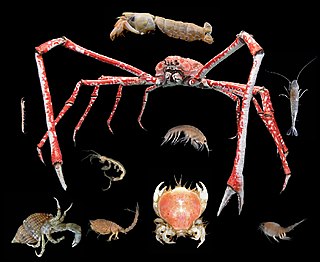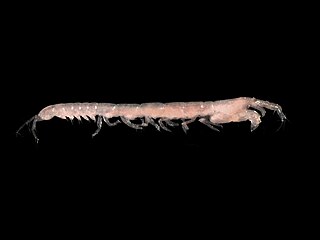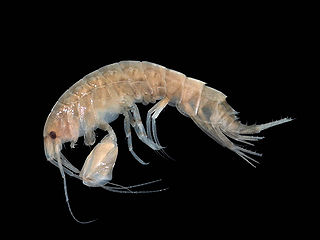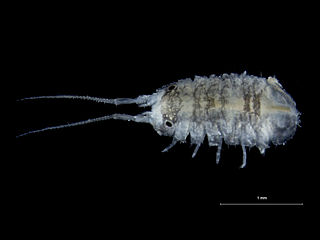
Malacostraca is the largest of the six classes of crustaceans, containing about 40,000 living species, divided among 16 orders. Its members, the malacostracans, display a great diversity of body forms and include crabs, lobsters, crayfish, shrimp, krill, woodlice, amphipods, mantis shrimp and many other, less familiar animals. They are abundant in all marine environments and have colonised freshwater and terrestrial habitats. They are segmented animals, united by a common body plan comprising 20 body segments, and divided into a head, thorax, and abdomen.

The Decapoda or decapods are an order of crustaceans within the class Malacostraca, including many familiar groups, such as crayfish, crabs, lobsters, prawns, and shrimp. Most decapods are scavengers. The order is estimated to contain nearly 15,000 species in around 2,700 genera, with around 3,300 fossil species. Nearly half of these species are crabs, with the shrimp and Anomura including hermit crabs, porcelain crabs, squat lobsters making up the bulk of the remainder. The earliest fossil decapod is the Devonian Palaeopalaemon.

The crustacean order Tanaidacea make up a minor group within the class Malacostraca. There are about 940 species in this order.

Leptostraca is an order of small, marine crustaceans. Its members, including the well-studied Nebalia, occur throughout the world's oceans and are usually considered to be filter-feeders. It is the only extant order in the subclass Phyllocarida. They are believed to represent the most primitive members of their class, the Malacostraca, and first appear in the fossil record during the Cambrian period.

Eucarida is a superorder of the Malacostraca, a class of the crustacean subphylum, comprising the decapods, krill, Amphionides and Angustidontida. They are characterised by having the carapace fused to all thoracic segments, and by the possession of stalked eyes.

The superorder Peracarida is a large group of malacostracan crustaceans, having members in marine, freshwater, and terrestrial habitats. They are chiefly defined by the presence of a brood pouch, or marsupium, formed from thin flattened plates (oostegites) borne on the basalmost segments of the legs. Peracarida is one of the largest crustacean taxa and includes about 12,000 species. Most members are less than 2 cm (0.8 in) in length, but the largest is probably the giant isopod which can reach 76 cm (30 in).

Cumacea is an order of small marine crustaceans of the superorder Peracarida, occasionally called hooded shrimp or comma shrimp. Their unique appearance and uniform body plan makes them easy to distinguish from other crustaceans. They live in soft-bottoms such as mud and sand, mostly in the marine environment. There are more than 1,500 species of cumaceans formally described. The species diversity of Cumacea increases with depth.

The Ocypodidae are a family of semiterrestrial crabs that includes the ghost crabs and fiddler crabs. They are found on tropical and temperate shorelines around the world.

Stenopodidae is a family of decapods in the order Decapoda. There are about 6 genera and more than 30 described species in Stenopodidae.

Spongicolidae is a family of glass sponge shrimps in the order Decapoda. There are about 8 genera and more than 40 described species in Spongicolidae.

Crustaceans form a large, diverse arthropod taxon which includes such animals as crabs, lobsters, crayfish, shrimps, prawns, krill, woodlice, and barnacles. The crustacean group can be treated as a subphylum under the clade Mandibulata; because of recent molecular studies it is now well accepted that the crustacean group is paraphyletic, and comprises all animals in the clade Pancrustacea other than hexapods. Some crustaceans are more closely related to insects and the other hexapods than they are to certain other crustaceans.

Detonidae is a family of woodlice in the order Isopoda. There are at least 3 genera and more than 30 described species in Detonidae.

Janiridae is a family of isopods in the order Isopoda. There are more than 20 genera and 190 described species in Janiridae.

Cylisticidae is a family of woodlice in the order Isopoda. There are at least 4 genera and more than 60 described species in Cylisticidae.

Bathyporeiidae is a family of amphipods in the order Amphipoda. There are two genera in Bathyporeiidae:
Unciolidae is a family of crustaceans in the order Amphipoda. There are about 9 genera and more than 20 described species in Unciolidae.
Chydoridae is a family of water fleas in the order Anomopoda. There are more than 50 genera and 520 described species in Chydoridae.

Leptocheliidae is a family of malacostracans in the order Tanaidacea. There are more than 30 genera and 140 described species in Leptocheliidae.

Ovalipidae is a family of sand crabs in the order Decapoda. There are at least 3 genera and more than 20 described species in Ovalipidae. These were formerly members of the family Portunidae

Oziidae is a family of crabs in the order Decapoda. There are about 7 genera and more than 30 described species in Oziidae.
















